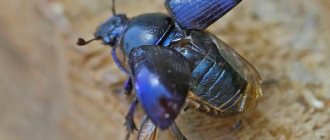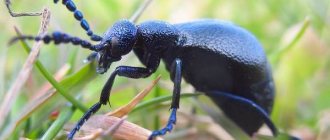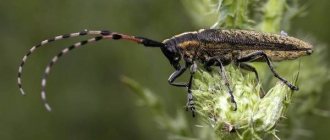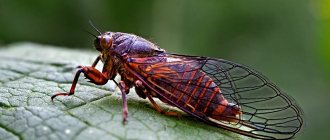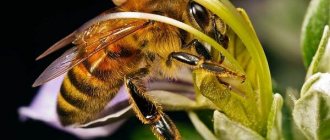Swimming beetle - a carnivorous insect that is a representative of the large family of Coleoptera. Due to their high adaptability to unfavorable environmental conditions, various species of this family can be found in Eurasian countries. Insects even inhabit North America and the Arctic regions.
The beetle lives in stagnant ponds, preferring deep water bodies with rich wildlife. After all, according to the way it feeds, the swimming beetle is a predatory insect, so it simply needs a good supply of food. However, if certain conditions are met, the diving beetle can feel great even in an aquarium.
Description and features
The diving beetle received a gift from nature with an elongated, streamlined body, which helps it move well in the water. On average, specimens grow to 45-50 mm. The color of individuals is most often nut-brown or black.
The body of a beetle is a fixed structure of three elements: the head, thorax and abdomen. The forelimbs, of which there are two pairs, help the beetle linger under water. It grabs onto plants with hooks with which these legs are “equipped.”
The hind limbs are adapted for swimming and are covered with hairs, and their design is similar to small oars. Even the swimming style itself is similar to how a boatman rows oars, the two hind limbs move simultaneously.
The insect also has well-developed wings, which it does not use often. The swimming beetle flies only when food runs out or its favorite water reservoir dries up. The eyes of the diving beetle are unusual. They are made up of nine thousand facets, small ordinary eyes.
This eye structure helps the insect to navigate very well under water and distinguish between stationary and moving objects. The organs for grasping food are very well developed - the jaws are sharp and powerful, which makes it possible to eat prey alive.
Swimmers spend most of their time underwater, but they must swim to the surface from time to time because they need fresh air to breathe. On the abdomen of the swimmer there are special-purpose holes through which oxygen enters and then goes through the trachea to all parts of the body.
In order to replenish the resources of necessary oxygen, the beetle swims to the surface and pushes its abdomen outward. The oxygen replenishment procedure should take place at least once every 15 minutes. Beetles use air not only for breathing; a special bag helps them control their descent and ascent.
Lifestyle
The swimmer easily floats to the surface of the reservoir, because its body is lighter than water. Descending requires more effort. To stay at the bottom of the reservoir, it needs to cling to a stone or plant. The beetle's forelimbs have special hooks that allow it to attach to any smooth surface. Insects are active at night, they hunt or go in search of a new home. Fauna lovers are interested in whether the swimming beetle flies or not? Adult males and females have well-developed wings. In search of favorable habitats, they fly tens of kilometers.
Before the flight begins, specific preparations take place. The beetle crawls ashore and empties its intestinal contents. It then fills the air sacs on the chest. Having reduced its body weight as much as possible, the swimmer takes off. When searching for bodies of water, it relies on sight. Noticing the shine, the insect dives down. Tactics often fail the beetles; instead of a pond, they end up on glass greenhouses or galvanized roofs. Many travelers die from a strong impact on a hard surface.
During the cold season, many insects hide in cracks or burrow into the soil. Where does the swimming beetle overwinter? Among the many species of insects, there are those that spend the winter in the egg, larval or adult phase. Insects living in Europe are characterized by immersion in diapause of adult beetles. After emerging from the pupa in the fall, the young beetles remain to overwinter in the litter or under the bark. Some of the swimmers return to the reservoir. When there is enough oxygen, they actively swim. Complete freezing of the surface forces the beetles to burrow into the mud and fall asleep until it warms up.
The enemies of swimming beetles are birds, small mammals, and fish. The dark color helps the insects blend in with the bottom rocks. Many parasites live on swimming beetles: nematodes, parasites, and water mites.
How long do swimming beetles live? The lifespan of adults ranges from several months to two to four years. Most beetles live for about 1 year. The shortest life cycle is found in representatives of the species Agabusfuscipennis, common in Europe and the Middle East.
Kinds
About 600 species of different swimming beetles are known. The following species live in mid-latitudes:
1. Fringed swimmer . The most common and famous species, as well as the largest specimen. It is distinguished by the presence of an ocher-colored border, which decorates the entire body of the insect. A grown individual reaches 30-35 mm. Such beetles are common in Europe and America, Japan, Transcaucasia and the Sakha Republic.
2. Latissimus swimmer . The largest and rarest species of diving beetles. Adults grow up to 45 mm. They like to settle in bodies of water with clean water and high oxygen content, which is why the population is declining. Listed as an endangered species in the Red Books of several states.
3. Phalarope or striper. It is found in bodies of water with stagnant water, where there is a lot of its favorite food - tadpoles. It is smaller in size than the fringed diving beetle; an adult is 12-16 mm. It can be found wherever there is standing water, as well as small fish and tadpoles, which it grabs and devours with extraordinary speed.
When a life-threatening situation arises, the beetle releases a toxic milky liquid that covers its body. An unpleasant-smelling liquid scares away potential enemies, and they lose interest in it. Beetles are common in Russia, the northern territories of the African continent, the islands of the Sea of Japan and East Asian countries.
4. Diving . These beetles are quite compact in size, growing up to 0.5 cm, and this is their maximum length. Among this type of insect the most familiar are:
- The flat diving fish is a strong and well-fed individual, covered with long and densely growing hairs. The sides and front of the back have an uneven, rough surface;
- The swamp dive is smaller in size even than the flat dive. The maximum value is up to 3.5 mm. It can be identified by the presence of red-red spots located in the eye area. Despite the name, such an individual can be found in forest lakes and slow-flowing rivers. Inhabits vast territories from the Atlantic Ocean to Sakhalin.
5. Prudovik . Lives in wild ponds covered with vegetation. The color is dirty brown, the wings are covered with a pattern in the form of transverse notches.
Enemies of the swimmer
The consequence of the appearance of beetles in fish farms or artificial reservoirs can be the extermination of large numbers of fish.
However, there are also creatures who eat the swimming beetle in a pond with great pleasure - these are various invertebrates, large fish, birds and mammals. In moments of danger, swimmers secrete an unpleasant-smelling liquid, which has a deterrent effect.
The larvae of diving beetles also have enemies. We are talking about an aquatic parasitic insect - an ichneumon fly, which has the strange name of prestwichia. Having discovered the egg of a diving beetle, the female ichneumon lays her eggs in it. The resulting parasite larva will eat the insides of the victim's egg until it turns into a pupa. The already formed adult equestrian is released into the world.
Video
Swimming beetle is a collective name for aquatic insects belonging to the order Coleoptera. In nature, there are 4 thousand species, 300 live in Russia. Beetles can fly and swim perfectly. They spend most of their lives in water. They prefer ponds and lakes with standing water. Adult swimmers and their offspring are active predators. They attack fish and fry, tadpoles, mosquito larvae, and mollusks. In fish farming areas, the appearance of a swimming beetle becomes a real disaster.
Lifestyle and habitat
In nature, it is very rare to find living creatures that can both fly and stay under water for a long time. The swimming beetle lives only in places where there is fresh water and there is no strong current. These beetles fully confirm their name by their way of life. 90% of the time the predator is underwater, tracking prey or resting. Rest is most often combined with replenishing oxygen supplies.
You can see how the beetle lies on the surface with its abdomen up, so it fills its organs with air so that it can then stay under water for some time and return to hunting.
The water beetle swims magnificently, and it’s rare that you won’t see it in any pond. Thickets along the shores of forest lakes and small lakes in water meadows often collect huge numbers of insects. The fast current apparently creates noticeable interference when hunting small predators, and they also have problems when they need to take in air, which is why the habitat is stagnant water.
Although the wings of an insect are adapted for flight, in order to take off, it needs to get to land. The beetle moves on land rather awkwardly, walking in a waddle, swaying from foot to foot. Swimming beetles leave their favorite body of water only in the event of drought and other natural causes of shallowing of the water area.
An interesting feature: swimmers are also active at night. They continue to hunt even in the dark; at this time of day they fly from one body of water to another. Beetles do not see very well at night, which is why they often get into trouble, mistaking surfaces with glare for water surfaces. When diving on wet and shiny objects, swimmers often break.
Its small size and conspicuous appearance should make the diving beetle an accessible prey item for other predators, but it has a defensive weapon in its arsenal. When danger arises, the beetle's glands release a cloudy white liquid that has a disgusting, pungent odor and a sharp, unpleasant taste. This deters even larger predators and is a guarantee of safety.
Relations within the community are quite complex, if not cruel. When two individuals meet, they start a battle for territory, biting and beating each other. Swimming beetles survive the winter cold in cozy burrows, which they make for themselves as frost approaches. At this time of year they sleep.
What does a water beetle look like?
Externally, the swimming beetle resembles other representatives of its family. Its main characteristics are as follows
- length is 4-4.5 cm,
- the color is predominantly black, but brown with an olive tint is allowed,
- the body is long, has a streamlined shape, which facilitates the process of movement of the swimmer in the water,
- the head, chest and abdomen of the insect are motionlessly articulated with each other, the head is pressed into the chest, and the chest smoothly passes into the abdomen thanks to the fused thoracic segments,
- compound eyes are located on different sides of the head and consist of a large number of simple ocelli, of which there can be up to 9 thousand. This allows the beetle to distinguish between many objects and plants,
- antennae act as organs of smell and touch,
- in the mouth of the swimmer there are strong jaws, with which they catch and tear their prey,
- two front pairs of legs allow you to grab prey and stay on plants,
- the wings are delicate and protected by hard elytra, which allows the insect to both swim and fly,
- the hind pair of legs are used as oars.
Swimming beetles can easily change their habitat , but they do so only out of necessity, when, for example, a pond dries up.
On the ground, water beetles move slowly and waddle in different directions. When walking, they walk with their front paws and push off with their back feet.
Nutrition
The swimming beetle in the photo looks like a harmless insect. But this is very far from reality, since the insect is a voracious predator. The greatest threat to all inhabitants of the reservoir is not even an adult, but a larva of the swimming beetle . This is one of the most merciless types of creatures that inhabit ponds.
The large crescent-shaped jaws are not used by the cub for chewing prey, but with their help the larva holds its trophy like pincers. Through them, a very toxic substance comes from the predator’s esophagus, which causes paralysis in the prey.
The next portion of the substance, which is ejected from the esophagus, decomposes the victim’s tissues to a jelly-like state, and the larva begins to absorb this substance. She has an immoderate appetite and resumes hunting as soon as she has dined. Interestingly, food for the larvae is only what moves; the larvae do not attack stationary objects.
Adult beetles are as insatiable as their larvae. Small fish, tadpoles, fry and other insects are not a complete list of what the diving beetle eats . A hungry beetle can attack frogs and fish, the size of which is close to 10 cm. Of course, one beetle cannot cope with it.
But the wounded fish attracts other swimmers with the smell of its blood, and then the attack occurs as a group. The beetles do not kill their trophy, but try to eat it alive, gnawing off piece by piece.
A large number of beetles can cause significant damage to fish populations in water bodies. Swimming beetles and fry live in the same aquatic environment, which sometimes leads to the complete disappearance of fish, since the fry are devoured by an insatiable animal.
Larval development
Diver larvae are characterized by a yellow, gray or brown color. There may be dark spots or stripes on their body. Externally, the larvae look like scorpions. They bear little resemblance to adult swimmers.
Basic nutrition for larvae in the first period of life:
- caviar,
- dragonflies,
- mosquitoes
The body is distinguished by a flattened head, a thorax with three segments and an abdomen of 8 segments. The larvae have 6 simple eyes. The oblong body is narrowed towards the end. There are various formations on the body in the form of spines, bristles and scales. The legs consist of 5 segments. Swimming hairs cover the legs and thighs. The paws have 2 claws.
The oral appendages are located transversely. The larvae do not have an upper lip, and the lower one is a wide plate, along the edges of which the palps are located. The oral apparatus moves in a horizontal plane. It is connected to the pharynx by channels. The larvae do not have a mouth opening, so food enters through the jaws (mandibles).
To read: Symptoms of tick-borne encephalitis in humans, how to recognize the disease
Insects ferment their prey not in the stomach, but outside. The larva immerses its mandibles into the body of the victim and injects digestive juice into it, which softens tissues and organs in a few minutes. The insect sucks the resulting mass into the throat. After this, the larva cleans the mandibles with its forelimbs. Since at this stage the swimmers are very voracious, they immediately go looking for the next victim.
The diving beetle larva goes through 3 instar stages, the last of which is the longest. At the beginning of autumn, the insect climbs out of the aquatic environment onto land and builds a cradle on the shore from plant debris and small pieces of soil. The larva pupates in an oval-shaped chamber for about a month. The soft and white pupa has an open type. After emerging from it, the imago is also characterized by a light color. But after a few hours, the body of the insects darkens and hardens.
Reproduction and lifespan
The swimming beetle is an oviparous insect, like many Coleoptera. With the first warm days, when the water in reservoirs warms up, the beetles leave their wintering place and begin to look for water spaces in which mating could occur. Since the whole process takes place under water, it often ends tragically for the female.
Having chosen a suitable female, the male sits on her back, securing himself on the slippery surface. He is helped in this by two suction cups located on his front legs. Moreover, the female spends the entire mating process under water, and her partner, who is on top, is able to breathe. The tip of the abdomen, protruding above the surface of the water, helps him in this.
The resistance preceding crossing and the process itself continue for a longer time than the insect is accustomed to doing without breathing. For this reason, situations arise when the partner may not have enough air and die. This is most likely to happen when the female has to mate with several males in a row.
If the process goes without any unpleasant incidents, the female attaches the clutch to the stems of plants, piercing them with the ovipositor, and lays eggs there one after another. One such clutch can include up to one hundred eggs, the size of which reaches 5 mm. The development of the swimming beetle is not a quick process. The larvae will appear only after 2-5 weeks, depending on weather conditions and water temperature.
The swimmer can remain in the larval stage for up to 2 months, then it emerges from the water and begins to move on land to dig a hole for pupation. The adult beetle will emerge from the pupa in 20-35 days. He will spend about another week in his hole, waiting until his covers harden, and then he will go looking for water.
Insects live on average about one year in the wild. Those who like to place a beetle in a home aquarium can expect it to live there for 2-3 years.
Difficult period
During the winter, swimmers hibernate. Immediately after waking up, mating season begins. Having left the underground bedroom, the beetle rises into the air and flies in search of a suitable body of water. In flight, it relies on its vision, which sometimes fails, and the beetle flops onto wet asphalt or a metal roof. It can also fall a few centimeters or meters from the reservoir, and then the rest of the journey has to be done on foot. On land, the swimmer moves very clumsily, but quite quickly.
Interesting Facts
There is an opinion that the diving beetle chooses weak and sick inhabitants of the pond as victims for attack, that is, it is, in fact, an orderly. The diving beetle usually does not show hostility towards a person who finds himself in the same water pool. But the bite is very painful even for a person.
The sharp pain associated with the bite may go away after some time, but swelling occurs in the bitten area, completely disappearing after 14-20 days. The wounded area must be washed, treated with disinfectants, bandaged and a cold compress applied.
Most often, beetles show aggressiveness towards those who try to catch them and pick them up. At home, experts do not recommend keeping swimming beetles and ornamental fish in the same aquarium, as the predator will attack them and can seriously injure them.
What to eat, lifestyle
The diet of the dung beetle is excrement, carrion, and mushrooms. They prefer to feed on cattle feces and manure - this is where the name comes from. They eat at home, pulling food into their burrow, which is placed at a depth of 15 to 50 cm.
Eating dung beetle
The excrement is rolled into balls of the correct shape. They roll to their place of residence, making incredible efforts. The weight of the food is several times greater than his own. Dung beetles can roll balls on the ground with their front and hind legs.
To prevent food from drying out, the beetles bury it underground, and when they get hungry, they take it out. Often in the process of rolling balls, clashes occur. The winner takes the prize. In hot weather, food protects dung beetles from overheating. The beetle climbs onto the ball, and after a few minutes its body temperature drops several degrees.
The big hard worker is active at night, during the day he hides in a hole or a secluded place, away from the light. Often a dung heap serves as a refuge for him. It determines the location of food by smell, flies through the air or crawls along the ground. During the flight, a heavy hum is created, and the landing is always “rocky”. It just falls to the ground.
In addition to feces, the beetle eats carrion and mushrooms. For this he is called the pasture cleaner. Dung beetles drink water in a special way. In the morning or evening, they spread their wings, droplets of dew collect on them, which gradually roll into the mouth.
Undesirable neighborhood
Having settled in a decorative pond, a predatory beetle attacks decorative fish and other inhabitants. Owners of ponds are faced with a difficult problem: how to get rid of the swimming beetle in the pond? The least labor-intensive way is to have crucian carp, which actively destroy the larvae of the swimming beetle. Another option is to temporarily install a pump or fountain that creates movement of the water mass. The insect prefers stagnant bodies of water, so it will leave its shelter and go in search of a better habitat.
If the above methods do not work, then all that remains is to drain the water, clean and disinfect the bottom. This will destroy the adults and larvae of the beetle. After treatment, water is poured in and new inhabitants are released.
Danger to humans
You can encounter a predatory beetle while swimming in a lake or in your own pool. The insect shows aggression towards humans extremely rarely. The bite is painful, but does not pose a threat to health. The swimming beetle bites in the water if it feels threatened. The pain from the skin puncture remains for several minutes. After some time, the wound swells and a lump may form. The beetles are not poisonous, so there is no allergic reaction.
The victim must be given first aid:
- wash the wound;
- treat with an antiseptic (iodine, hydrogen peroxide);
- apply a bandage;
- apply ice to relieve swelling.
Marriage "games"
Once in the water, the swimmers begin hunting, this time for the female. Having seen the lady, the gentleman will not waste time on courtship and other romance. He grabs it with his front paws and immediately gets down to business. In this case, the male is on top of the female and only he can expose his abdomen to the surface to replenish oxygen reserves. The female has to be content with the reserves under the elytra. And if only one suitor sets his sights on her, then everything will be fine, but if there are several males in a row, which happens at the beginning of the mating season, she will most likely die from suffocation.
Laying eggs
Immediately after mating has occurred, the female begins to lay eggs. Their length is about 7 millimeters and their diameter is 1.2 mm. One female lays about 1000 eggs per season, a particularly fertile one lays up to 1500. This is possible only with sequential maturation, so the whole process drags on until the end of June. Eggs are laid in plant tissue. For protection, the female cuts them with the ovipositor, however, this does not always save future offspring from parasites. One of the most dangerous enemies for swimming beetles is the prestwichia rider. These parasites lay several dozen of them in each beetle egg. The ichneumon ichneumon larva feeds on the diving beetle's egg, pupating inside it. Young parasites emerging from the dolls mate and then leave the shell. Prestwichia and caraphractus are the only enemies of swimming beetles.


